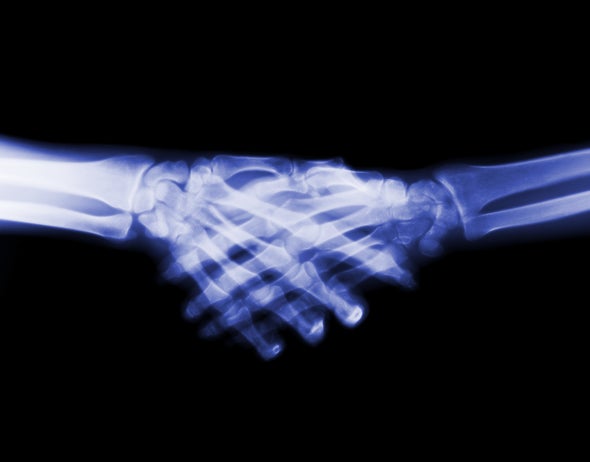This is Scientific American — 60-Second Science. I'm Karen Hopkin.
Exercise builds muscle. But it also strengthens bones. Exactly how exercise boosts bone strength is a matter of debate — and a subject of scientific scrutiny. Now, a new study in mice shows how a hormone secreted by active muscle cells triggers bone remodeling.
Physical activity stimulates the release of multiple molecules from skeletal muscle. Take irisin, for example. This hormone, named after the Greek messenger goddess Iris, is produced by running rodents — and by us humans when we do high-intensity aerobic training. Once it's generated, irisin improves bone density and strength.
To find out how, Bruce Spiegelman and his colleagues at the Dana Farber Cancer Institute and Harvard Medical School took cultured bone cells and located the receptor to which irisin binds. This receptor protein is particularly abundant on cells called osteocytes. These cells are the master regulator of bone remodeling and the most abundant cell type in bone.

"What we found interesting in this paper is the magnitude of the effects we get in terms of irisin acting to stimulate osteocytes and preventing their death in culture. Also, their ability to make a key protein, sclerostin, under the stimulation of irisin."
Sclerostin is a protein that actually stimulates the breakdown of bone. That irisin, which builds bone, would promote the production of sclerostin, which destroys it, may seem counterintuitive. But Spiegelman says that its this bit of bone breakdown that signals the body to engage in some skeletal renovation.
The results appear in the journal Cell.
Boning up on the actions of irisin could help us work out how we can derive the most from our workouts. And possibly keep our bones dense enough to keep us dancing in our dotage. And:
"The new work identifying the receptor also allows us to really much more easily identify what are other target cell types for irisin. With particular reference to neural cell types. Where there is suggestive evidence by us and others that irisin may play a neuroprotective effect in disorders such as Alzheimer's Disease, Parkinson's Disease and ALS."
Thanks for listening for Scientific American — 60-Second Science. I'm Karen Hopkin.












